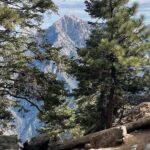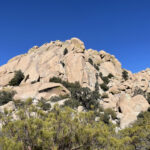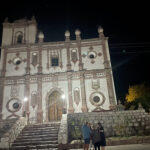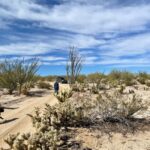We decided to take a pass on the tour that boasted of “cars thrown by horses.” On further reflection, they probably only meant carts drawn by horses, but there were better things to do, anyway!
So here we are, on the island known as Hispaniola. It’s sandwiched between Cuba and Puerto Rico, and is split into Haiti and Dominican Republic.
The island was Columbus’s first New World landing. He left his mark here in – a well established Spanish colony, with handsome 17th century buildings. We toured the first cathedral in the Western hemisphere – quite a beautiful building.
And some kitsch: just down the beach from our hotel is a bar/restaurant in the shape of a boat that looks suspiciously like the drawings in our history books of the three ships that Columbus set out in. I wouldn’t take that one out of the harbor, much less cross the Atlantic in it!
What are we doing here? Earlier this year, we planned to refresh our diving skills. We were thinking Cabo San Lucas, swim in warmer parts of the Pacific. But our yoga instructors, Frank and Serpil, mentioned that they had reservations at a hotel here and were looking for another couple to travel with. They had been here last year, and raved about the place. We checked out the diving and found that there is an onsite PADI dive tour and training shop. So it was a “go”.
The location is stunning. Here, on the Carribbean Sea, at Boca Chica, the bay is well protected. White sands, pale aqua waters that are about body temperature. Hot sun in the afternoons, punctuated by rainstorms that cool everything off. Of all the tropical places we’ve been, the climate is the most appealing. The beach has an expanse of shade palapas, with chairs under each one. You can stake out a set of chairs in the AM, and return on and off all day. There doesn’t appear to be any poaching of chairs or towels.
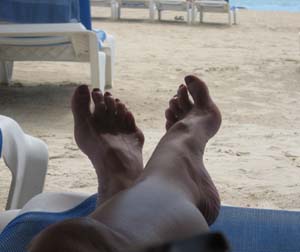
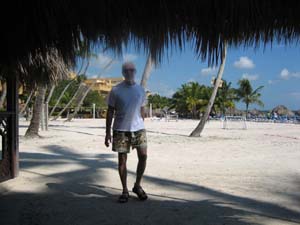
This is our first experience with “all-inclusive” on this scale. It’s got some advantages – there’s little stress in choosing your restaurant. Don’t like your dinner? Get another one! At lunch, there are ribs at one restaurant and lobster at the other. Go to both! (And I’ll comment, there are some number of people who are sampling a LOT.)
We really enjoyed getting to know Frank and Serpil better.
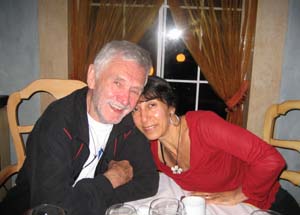
On Wednesday, we started our Advanced Open Water training. We might have been wiser to start a day later, because the water conditions were rough and visibility poor. But we wanted to get an early start. The plan was to do a wreck dive introduction – the “Tanya” was sunk off of Juan Dolio (just down the coast a few miles) about five years ago, and is attracting the coral reef creatures that will grow into a beautiful artificial reef after some time. Both of us were having trouble at the surface. We were both feeling rusty on our diving skills and very nauseous from the boat ride. Fred got back in the boat, Carolyn took a few deep breaths and decided to make the dive anyway. Daniel, our dive instructor, was Carolyn’s buddy for the dive, and she got comfortable once below the waves.
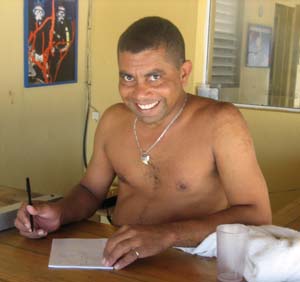
Like most dive instructors, Daniel’s a ham. On the wreck, he mimed the scene from Titanic, where the young stars hang from the prow of the boat. In later dives, he lounged into an invisible La-Z-Boy and blew impressive “smoke” rings, tucked his legs into a flippered lotus position, and twirled a young woman from Italy in a gravity-free dance. All good fun, and very much in the tradition.
The next dives were to practice navigation and deep diving. We had to calculate a dive plan that included a deep dive followed by two additional dives. Our original dive certifications were in 1973 (Fred) and 1980 (Carolyn). A lot has changed since our training. And we’ve only done a small amount of diving in the last few years. We’re very rusty, but the dive tables started to look familiar again after a few passes through them.
Our final dive was Underwater Naturalist specialty. There are too many varieties of sea life to recount here, but these were the highlights:
– sponges – tube, volcano, vase and rope and many less well-shaped clinging to coral or rock foundations.
– fire coral in flat and “finger” formations
– brain corals – from big heads, some of them!
– jellyfish – large, white
– many forms of anemones
– parrotfish, trumpet fish, sargent majors that see us as curiosities
– a member of the eel family, sand colored with slightly different colored circular markings. Usually reclusive, it was in the open and allowed Daniel to touch it
– cleaner shrimp
– sea fans, sort of ruddy colored with indigo bases
– a large hermit crab in a conch shell
It takes a while to get familiar with the varieties, and to be able to identify them underwater. As our divemaster reminded us, the special attractions of the reefs are not the big fish, but the tiny creatures that take patience to find and observe.
A few reflections on the country. A big caveat: our exposure was very limited and so our observations can’t possibly represent the country as a whole. In our hotel, the hospitality was excellent. All of the staff were friendly and competent. We were treated with respect and warmth. We ventured outside the hotel only once on our own and once on a city tour. It’s clear that the country is poor; the hotels have a lot more security than you’d see in more prosperous locales. And the hotel was perhaps overstaffed – a sign that labor is inexpensive. Also, we were mobbed by hawkers and a few beggars outside our hotel. From our tour bus, too, we saw some markets that showed the sad poverty in the grubbiness of their offerings. In recent years, the country has apparently seen tourism as its engine for economic growth. (Replacing sugar cane as the major source of income.) I hope they succeed.
